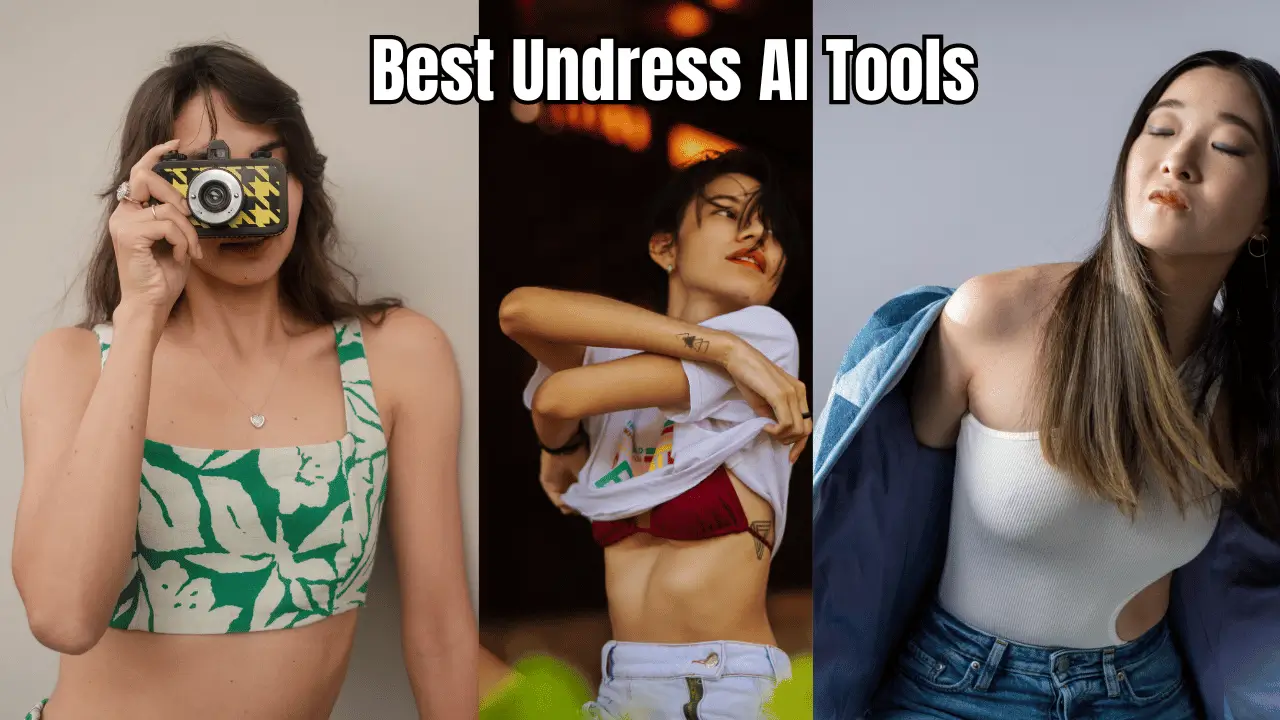Free Undress AI Tool: Remove Clothes From Photos Easily!
Ever imagined having the power to digitally reshape reality with a simple click? The emergence of "undress AI" technology is not a futuristic fantasy but a present-day capability that is sparking conversations around ethics, art, and the very nature of digital image manipulation.
The core function of an "undress AI tool" revolves around the capacity to analyze images and, through sophisticated algorithms, realistically remove clothing from the subjects depicted. This capability, once confined to the realm of science fiction, is now accessible through various platforms and applications, each touting its unique approach to image transformation. At the heart of these tools lies artificial intelligence, specifically deep learning models that have been trained on vast datasets of images to understand human anatomy and clothing patterns. These models, often leveraging techniques like stable diffusion and generative adversarial networks (GANs), are capable of generating plausible reconstructions of the human form beneath the removed clothing, leading to images that can be strikingly realistic.
| Aspect | Details |
|---|---|
| Tool Type | AI-powered image manipulation software |
| Primary Function | Digitally removes clothing from images, creating the illusion of unclothed individuals. |
| Underlying Technology | Deep learning algorithms, including stable diffusion and generative adversarial networks (GANs) |
| Accessibility | Typically offered as an online service or downloadable application |
| Cost | Varies; some offer free trials or basic versions, while others require subscriptions or payment per image. |
| Privacy Concerns | High; potential for misuse, non-consensual image alteration, and privacy violations. |
| Ethical Considerations | Significant; raises questions about consent, exploitation, and the creation of deepfakes. |
| Applications | Potentially for artistic expression, fashion design visualization, or entertainment, but often associated with malicious intent. |
| Image Security | The safety and security of uploaded and processed images vary by platform, requiring careful consideration. |
| User Responsibility | Users bear the responsibility for ethical use and must be mindful of the potential harm caused by misusing the technology. |
| Reference | Electronic Frontier Foundation - DeepNude Was Shut Down, But the Damage Lingers: Artificial Intelligence Poses New Threats |
The proliferation of "undress AI" tools has been fueled by the increasing accessibility and affordability of AI technology. Many platforms offer their services for free, at least for a limited trial period, making them available to a wide range of users. For instance, some services grant new users a certain number of free "clothing removals" per day, allowing them to experiment with the platform's capabilities without immediate financial commitment. The business model often revolves around offering a premium subscription or charging per image for more advanced features, higher resolution output, or to remove watermarks.
- Movierulz Original Your Ultimate Destination For Latest Movies
- Movierulz Padmavati Hindi Movie Download Your Ultimate Guide To Streaming And Downloading
While the allure of these tools might stem from curiosity or a desire to explore creative possibilities, the reality is that the potential applications are far more diverse and, in some cases, deeply troubling. For example, fashion designers might utilize "AI clothes remover" to visualize how garments fit and drape on various body types without the need for physical prototypes. Artists could employ the technology to enhance or modify images for artistic projects, achieving a seamless and realistic finish. However, the ethical implications loom large, overshadowing any potential benefits.
The most significant concern surrounding "undress AI" is the potential for misuse and the infringement upon personal privacy. The ability to digitally undress individuals in images without their consent raises serious ethical red flags. Imagine a scenario where someone's photograph is uploaded to one of these platforms, and an altered, unclothed version is generated and disseminated online. The consequences could be devastating, ranging from emotional distress and reputational damage to potential legal repercussions. The creation of "deepnude" images, as they are often referred to, without the knowledge or consent of the individual depicted is a clear violation of privacy and can be considered a form of sexual harassment or even sexual assault.
Several platforms explicitly advertise themselves as "free deepnude apps" or "AI clothes removers," further blurring the lines between harmless experimentation and malicious intent. These platforms often entice users with the promise of effortlessly transforming images with just a few clicks, downplaying the ethical considerations involved. The ease of use and the readily available nature of these tools make them particularly dangerous, as they can be exploited by individuals with harmful intentions, such as creating revenge porn or engaging in online harassment.
- Movierulz Pelli Sandadi Your Ultimate Guide To Staying Updated
- Movierulz Pirates Of The Caribbean 5 The Ultimate Guide For Movie Enthusiasts
Companies offering "AI clothes remover" services often attempt to address privacy concerns by implementing security measures to protect user data and prevent the unauthorized distribution of altered images. They may claim to encrypt uploaded images, guarantee the confidentiality of user information, and implement policies against the creation of explicit content. However, the effectiveness of these measures is often questionable, and there is always a risk of data breaches or misuse of the technology. Moreover, even with the best security protocols in place, the mere existence of these tools creates a climate of fear and mistrust, as individuals may worry about their images being altered and shared without their consent.
The debate surrounding "undress AI" is further complicated by the issue of artistic expression. Some argue that these tools can be used for legitimate artistic purposes, allowing artists to explore themes of nudity, sexuality, and the human form in new and innovative ways. They contend that as long as the images are created with the consent of the individuals depicted and are not used to exploit or harm anyone, they should be protected under the umbrella of artistic freedom. However, this argument often fails to address the power imbalance inherent in the technology. Even when an individual consents to having their image altered, there is always a risk that the resulting image could be used in ways that they did not anticipate or approve of.
The legal landscape surrounding "undress AI" is still evolving, and there are currently no specific laws in many jurisdictions that directly address the issue. However, existing laws relating to privacy, defamation, and copyright may be applicable in certain cases. For example, if an altered image is used to defame or harass an individual, they may have grounds to sue for damages. Similarly, if an altered image infringes upon someone's copyright, they may be able to take legal action to protect their intellectual property. As the technology becomes more sophisticated and widespread, it is likely that governments will need to enact new laws to specifically address the ethical and legal challenges posed by "undress AI."
Several "AI clothes remover" tools are currently available online, each with its own unique features and capabilities. Unclothy, for instance, is an AI tool specifically designed to undress photos, leveraging advanced AI models to automatically detect and remove clothing from uploaded images. Undress VIP claims to offer a free AI service that can undress people in photos, although users should exercise caution due to the ethical concerns involved. Slazzer 3.0 is another free "undress AI tool" that is available online, offering users the ability to remove clothes from images with a high degree of accuracy. Pincel AI provides users with three different options for image manipulation, including the ability to "nudify" images by removing clothing. Anieraser's "AI clothes remover" is an advanced online tool designed to help users remove clothing from images seamlessly. These tools are often compatible with both iOS and Android devices, offering a consistent user experience across a range of smartphones and tablets.
The functionality of these tools is typically straightforward. Users simply upload an image to the platform, and the AI algorithms analyze the image to identify and remove clothing. Some tools offer a brush tool that allows users to manually select the areas where clothing should be removed, providing greater control over the final output. The AI then attempts to reconstruct the image, filling in the gaps left by the removed clothing with plausible renderings of the underlying anatomy. The quality of the results can vary depending on the sophistication of the AI model, the quality of the original image, and the complexity of the clothing. In some cases, the results may be realistic and convincing, while in others, they may appear artificial or distorted.
The use of "AI clothes remover" tools also raises questions about the responsibility of the developers and distributors of these technologies. Should they be held liable for the misuse of their tools? Should they be required to implement safeguards to prevent the creation of harmful or illegal content? These are complex questions that require careful consideration. Some argue that developers should not be held responsible for the actions of their users, as long as they have taken reasonable steps to prevent misuse. Others contend that developers have a moral obligation to ensure that their technologies are used responsibly and ethically. The debate over developer responsibility is likely to continue as "undress AI" becomes more prevalent.
Ultimately, the future of "undress AI" will depend on how society chooses to regulate and govern its use. It is essential to strike a balance between fostering innovation and protecting individuals from harm. This will require a multi-faceted approach, including the development of clear ethical guidelines, the enactment of appropriate laws, and the promotion of media literacy and critical thinking skills. Individuals need to be aware of the potential risks and ethical implications of "undress AI," and they need to be empowered to make informed decisions about how their images are used and shared online. Only through a concerted effort can we ensure that this powerful technology is used responsibly and ethically, and that the privacy and dignity of individuals are protected.



Detail Author:
- Name : Ms. Kasandra O'Reilly
- Username : camryn33
- Email : smith.jackson@rath.com
- Birthdate : 1979-12-18
- Address : 38739 O'Keefe Drives Collierhaven, HI 29074-8304
- Phone : (540) 792-9317
- Company : Will-Donnelly
- Job : Highway Patrol Pilot
- Bio : Sed doloremque rerum aliquam placeat ullam. Voluptatem cupiditate dolor eveniet in voluptatem. Adipisci reprehenderit ipsum sunt laudantium. Dolorem enim recusandae qui quia vero velit.
Socials
facebook:
- url : https://facebook.com/alisa_green
- username : alisa_green
- bio : Est commodi perferendis alias consequatur consectetur qui inventore.
- followers : 566
- following : 905
linkedin:
- url : https://linkedin.com/in/green1985
- username : green1985
- bio : Nobis harum quod quis quae.
- followers : 4613
- following : 2552
tiktok:
- url : https://tiktok.com/@green2011
- username : green2011
- bio : Occaecati maiores qui eos quaerat.
- followers : 2979
- following : 626
instagram:
- url : https://instagram.com/alisagreen
- username : alisagreen
- bio : Qui quis laborum voluptas ducimus. Rem consequatur qui saepe voluptatem non.
- followers : 3922
- following : 898
twitter:
- url : https://twitter.com/green1993
- username : green1993
- bio : Fugiat ad soluta occaecati culpa autem. Cum et voluptates doloribus amet. Minus quo in eaque eos. Iste exercitationem et modi unde fuga rerum nam.
- followers : 1894
- following : 2259